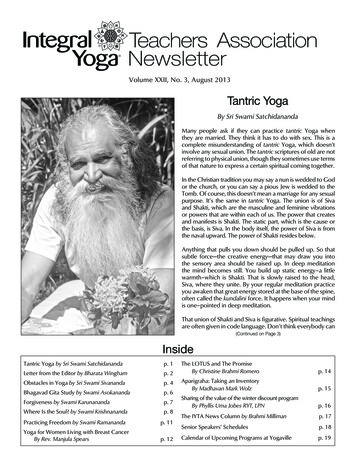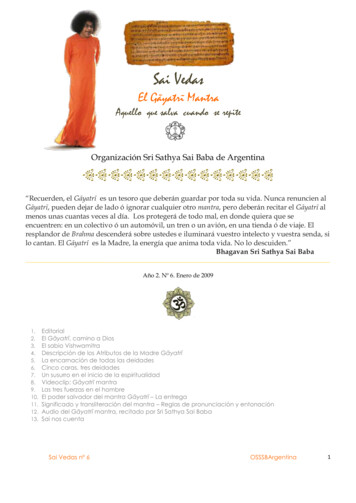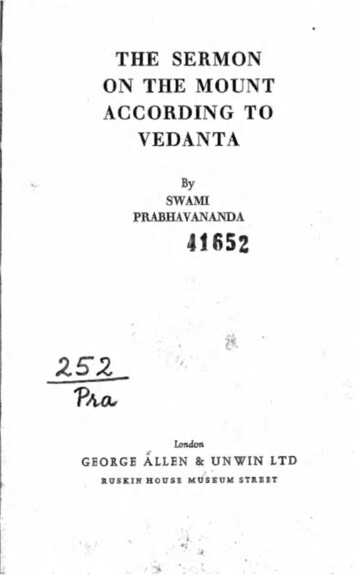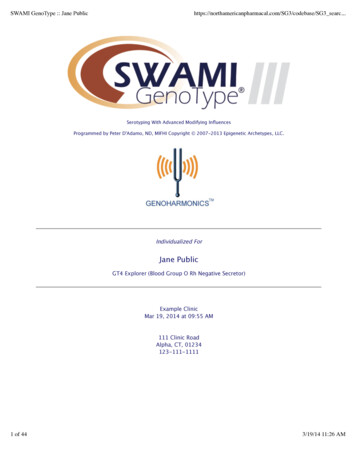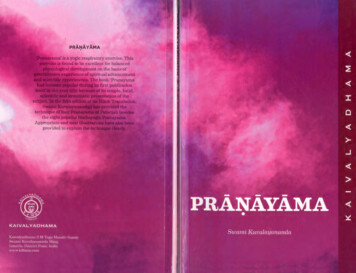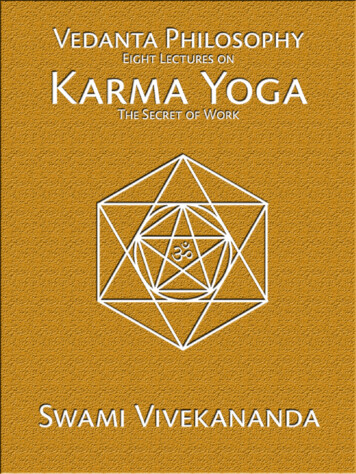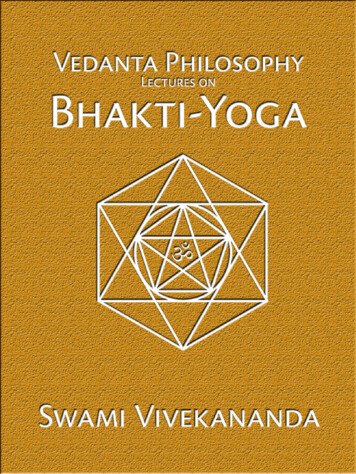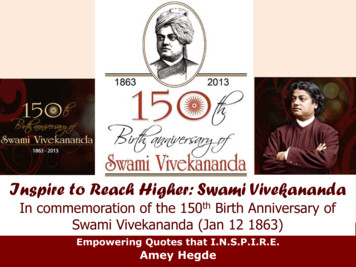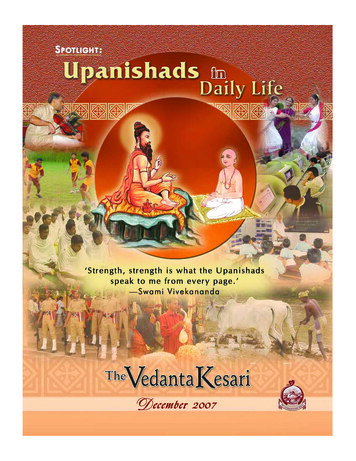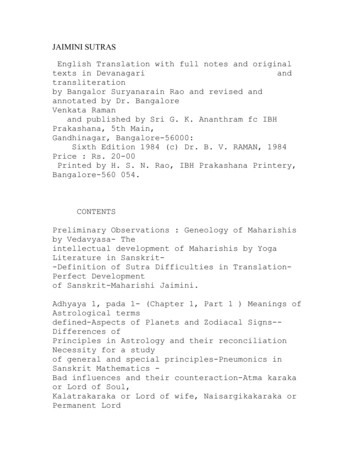
Transcription
An introduction to VedasBy Swami Shantananda Puri Maharaj,Written during July to August, 2013This documentcontains a briefintroduction tothe Vedas.A. Origin of Vedas and their expansion:Out of the four Vedas, namely, Rigveda, Yajurveda, Samaveda and Atharvaveda, the firstthree alone are used in practice and that is why those three Vedas are called the triad ortrayee. Here again, as Hinduism was originally based on the performance of fire sacrifices,called yagas and yagnas, the mantras of Yajurveda were used for pouring oblations in thefire, Rigveda was used for praising the Lord / praising the Gods, in the form of prayers, andSamaveda was being sung to tunes. “YAJUSHA YAJETA, RICHA STOOYATE, SAMNAGAYATE”. Actually Samaveda may not be considered as an independent Veda as the majorportion of the mantras was taken from the Rigveda and set to tunes. In fact, people whowanted to study Samaveda, had to study music for about 2-3 years, and only then were theyallowed to recite the Vedas.The Samaveda contains the mantras for white magic also. The Atharvaveda containsamongst various subjects, some mantras for black magic in the form of certain kriyas /rituals for getting our enemies killed, invoking serious ailments in their body, etc.In the Ekagni Kanda, which is a part of one of the Vedas, certain mantras have been given.These mantras are for different situations. For example, if a reliable servant or cook hasgiven a notice that he wants to go home or the servant leaves for home on leave and later
An introduction to Vedascommunicates that he does not want to return to the job, by chanting some of the specificmantras, the servant himself will come forward, express his change of mind and rejoin.There are also mantras for farmers to protect the crops from various things such as insects,calamities, etc. In such cases, before the farmers start sowing the seeds, a Brahmin from thevillage who knows the relevant mantras writes it on four palm leaves or copper plates andthese are kept buried in the north, south, east and west of the plot of land. No insecticidewas required as no insects would attack the crops. These are all lost to the world as thepresent day priests or scholars are not aware as to which mantra is to be used for whicheffect.Vedas consist of 3 portions. Each Veda is divided into:1.Samhita: This is a collection of all the mantras which are to be used at variousoccasions in one’s lifetime. During a man’s lifetime, there are supposed to be 16samskaras or rituals. Say for example: jatakarma (as soon as the child is born, he /sheis purified), namakarna (giving a name), investing the child with a sacred thread(upanayanam ceremony), marriage ceremony, and ultimately funeral, etc. Thevarious mantras to be chanted at each occassion are all in this collection calledSamhitas. As all these Samhitas came from Guru to disciple by rote1, and no ancientwritings are available. They are known as Shrutis (those that come from generationto generation by hearing and getting by rote). India being a big country, even thoughthe same Vedas were repeated in each state, like Maharashtra, Bengal, Orissa, etc.,there have been some minor changes in the versions of the Vedas repeated invarious places and each one of them is called an ascension [sākha]. There were 1000such ascensions in Samaveda and 100 in Yajurveda, etc., but in due course many ofthem have been irretrievably lost to the world. In each Veda, only two to threesākhas are available currently. The most important of them is Taittiriya shakha inKrishna Yajurveda. Similarly, in Samaveda, two or three are available like Rarayanasakha,.Kanva [Madhyandina] sākha, etc.2.Brahmana: The second part of the Vedas [for each Veda] is called Brahmana. Andeach Veda has its own Brahmana like shatapatha brahmana, gopatha brahmana, etc.The Brahmanas were considered as a commentary on the samhitas. Thesebrahmanas specify as to which mantras in the samhita are to be recited on specificoccasions like marriage, funeral, etc. and the various yagas [fire sacrifices].1Rote means by memory.Page 2 of 8
An introduction to VedasThere are two different categories of Yajurveda – 1] Krishna Yajurveda and 2] ShuklaYajurveda, i.e. black and white. The difference is because in Krishna Yajurveda theBrahmana is mixed up in the samhita itself while in the Shukla Yajurveda, thesamhitas and brahmanas are separated. Further, originally there was only KrishnaYajurveda, but a sage called Yagnavalkya who was annoyed with his Guru, vomitedback the entire Krishna Yajurveda ( this is a literary expression which is to beunderstood as discarded) which he had learnt from his uncle, Sage Vaisampayanaand did tapasya for several years and got a new Yajurveda known as ShuklaYajurveda from the Sun God.3.Aranyakas: The third part of the Vedas is called “Aranyakas” of which form a part ofUpanishads. The Aranyakas were mainly meant for those who went to the forest andwanted to conduct yagas and yagnas mentally through imagination as they neverhad huge wealth to conduct them physically. The Upanishads, which are part of it,contain a description of the indescribable and inconceivable ultimate Supreme Beingcalled the Brahman and the ways to reach it. In fact, in the non-dualistic philosophy(Advaita), propounded by Adi Shankara, the word Vedas (scriptures) was meant toconnote only Upanishads while certain cults like Arya Samaj, etc. consider theSamhitas only as the main Vedas. The Upanishads contain conversations betweenGuru and disciples and also contain the knowledge obtained through the directexperience of the sages.The Samhita portion and a few of the Upanishads are chanted with upward accentuationknown as udatha in some places, anudatha [downward accentuation] in some other places,and swarita [neutral] in other places. The books contain notations of the syllables that haveto be with upward accent, those with a downward accent, and those in a neutral way. If thepronunciation of the Vedas is done wrongly in any place, it could result in calamity, not onlyfor individuals but for the entire world, and that is why the pronunciation of every syllablecorrectly is extremely important. It is also warned in the books related to the Vedas thatnone of the mantras should be sung like a song, nor should it be mixed with any other soundlike the weeping of a child, or conversations between audience, etc. It is also prohibited toplay on any musical instrument like the veena, harmonium, etc. while chanting thesemantras. The entire Samhitas are based on sound effect and the effect should not bedistorted or changed or adulterated by other sounds.Even though the pronunciation and versions may vary from North India to South India,whatever is traditionally accepted in the individual’s state of birth and the state in which hegrew up is acceptable in that region – as per an allied text called Pratisakhya, which is a textsupplementary to the Vedas.Page 3 of 8
An introduction to VedasThe Samhitas are called the Karmakanda [ritualistic text], the Brahmana is called theUpasanakanda [meditation, worship, etc.] and the Upanishads are called the Jananakanda[the book of the Ultimate Knowledge].As the Vedas were to be preserved in their pristine purity of pronunciation without anymistakes in phonetics creeping into them, some unique methods of chanting them werepromulgated like two words at a time and several number of times again and again wereadopted and Max Mueller had praised eloquently about them. The Vedas are chanted invarious series as pada, krama, ghana, jhata, etc. While pada and krama methods are verycommonly taught in various schools called pathasalas, very few graduate to the highermethods of chanting like ghana and jhata. While in South India, all these methods are wellpreserved by a good number of priests, I have not personally come across such experts inNorth India during my stay of 65 years there. To crown it, a particular branch ofpractitioners of 19th century origin chant the Vedas uniformly in a sing song way during theirhavan ceremony without following the rules of udatha, anudatha, etc.B. Essentials for learning the VedasIn order to learn the Vedas, there are six limbs [texts] which are to be mastered first beforeventuring to learn the Vedas. The six limbs are:1.Siksha [phonetics]2.Vyakarna [grammar]3.Chhandas [the various figures of speech, etc.]4.Nirukta [special dictionary for the special meanings of vedic words]5.Jyotisham [astrology]6.Kalpa [the elaborate methods of various types of puja / worships]The aforesaid six limbs are more relevant to the samhitas portion of the Vedas. These sixlimbs have been explained below.Siksha: The text on siksha like Panini siksha deal with how important it is to pronounce asper the notations and how certain heavy consonants like ‘bha’, ‘kha’, etc., are to bepronounced and how the Vedas should be read, etc. For instance, it is told that one shouldnot chant the mantras in a very hurried manner but in a moderate way. While doing thechanting, one should not move one’s head up and down, etc. according to the specifiedtunes. One should not sing the Vedas in musical ragas or tunes.Page 4 of 8
An introduction to VedasThis is specifically mentioned in the following verse in Siksha Shastra:Geeti Seeghree Sirahkambee Likhita Pathaka --------- PathakadhamahThe above verse means that the one who sings the Vedas like a song; or the one who goeson chanting very quickly; or the one who during recitation keeps nodding ones’ head; or theone who recites the Vedas from a book or a written manuscript and not by heart; suchpeople are considered as the worst type of reciters of Vedas.Vyakarna: This is essential for splitting the compound words while chanting as any wrongsplitting will lead to calamities.Chhandas: Even though according to Sage Pingala 2 , there are several thousands ofalankaras which are used as Chhandas in Sanskrit poetry, only about six or eight of them areused in the Vedas, like anushtup, tryashtup, jagati, gayatri3, etc. The purpose of these is tolimit the number of syllables in each line and also to specify the number of syllables of longduration and short duration, etc. This limitation is essential for us to catch hold of theinfinite cosmic energy and bring it for our use just as a limited vessel like a bottle is used forbringing the holy water of the immense expanse of Ganges from Haridwar.Nirukta: The Vedic Sanskrit language is not like a normal language. The words, includingpersonal nouns, have got deeper meanings including their true esoteric import. The Vedicmeanings for the words are given in Nirukta.Jyotisham: The purpose of astrology was not originally meant to find out as to when onebecomes prosperous, when one gets a promotion, and one meets with an accident, etc. Itwas meant to find out the appropriate time which will be conducive and lead to success forthe performance of yaga or yagnaya .Kalpa: People accustomed to rituals will have to do formal worship of various Godseveryday [called panchayatana puja] where 5 gods are worshipped with Shiva in the form ofBanalinga [which is available in Omkareshwar or Narmada river; these are all stones], Vishnuin the form of Saligrama, Sun in the form of a Crystal, the Divine Mother in the form of aspecific red stone and Lord Ganesha in another form of red stone – all available in differentrivers. In addition we have seasonal worships at the time of specific festivals like thebirthday of Rama, Krishna, etc., so the detailed method of worship in all these cases and thevarious fasts to be undertaken [vratas], etc., is available in the Kalpasutras, for instance inParasurama Kalpasutra.23He wrote books on Chhandas.Infact Gayatri mantra is a mantra appearing in a meter called Gayatri.Page 5 of 8
An introduction to VedasOnly after having mastered all these six limbs, is one authorised to learn the Vedas.The one question which haunts most of the women in India is why ladies are prohibitedfrom chanting the Vedas. The Vedas contain many portions, basically sound effects, whichwork like laser beams and pierce the womb/impair fertility. In fact in the ancient editions ofVedas, it is written in many places that the pregnant women sitting and listening shouldvacate that place and move out. I have seen this effect in the case of a colleague’s daughterin law. Further there are hymns which can transform a female into a male by altering thehormones. No woman for that matter is prevented from reading the Vedas quietly. Allprohibitions and injunctions are all in the sole interest of the persons who chant and nochauvinistic approach is intended.C. Principal reference books for followers of AdvaitaIn the Upanishads and Vedas, the various chronological creations of the sky, the earth, thefire, the air, etc. are given in different sequences. In this way, there are certain smallvariations in the description of events in various Upanishads. Further, in the six systems ofphilosophy, like sankhya, etc., who also believe in the indisputable authority of the Vedas,they argue that the Upanishad mantras refer only to the primordial nature called prakrti orpradhan and not to a Supreme entity called Brahman. In order to reconcile the variations inthe Upanishads and also to establish the real purport of the Upanishads, the Brahmasutrawas written by the oldest of sages known as Veda Vyasa. As the Brahmasutra was inmnemonic formulae, in due course of time, people were unable to interpret the meanings.Hence, the great stalwarts like Adi Shankara, Ramanuja, etc., have written detailedcommentary on them called Bhashya. In due course people were not able to understandeven those commentaries and certain authors like Vachaspati Misra, Govindananda etcwrote commentary on the Bhashyas known as Bhamati, Ratnaprabha, etc.Hence in respect of people who are after Knowledge, the main Bible is a triad consisting of: The ten principal Upanishads The Brahmasutra [no doubt along with its commentaries], and The Bhagawad Gita4 [which is a deemed Smriti].When the original inhabitants like the maharishis of yore, began to form societies or villagesand lead a communal life, the rules and regulations for regulating them in the interest of theentire society were formed by various maharishis and kings and they were all known asSmritis. The texts were all based on the basic tenets of the Vedas and were called Smritis.They were called Smritis because they were all written on various subjects like partitioning4Bhagwad Gita with commentary of Adi Shankaracharya is preferred. Also the book on Bhagawad Gita bySwami Chidbhavananda is good and is available in Chennai.Page 6 of 8
An introduction to Vedasof family property, marriages of girls, and conduct and behaviour towards various elders,etc., in normal life or in specific stations of life like monkhood. In Advaita philosophy, wehold only the Vedas (shrutis) and smritis as authority and Puranas or mythologies areconsidered as subordinate to them. It is some of the dualistic sects who accept the Puranasor the mythology also as an authority.D. UpanishadsThere were around 108 Upanishads some decades ago, but currently there are some moremanuscripts since that have been found out and it is expected that there are more than 180Upanishads.Among them, the principal ones are only ten Upanishads belonging to different Vedas:1.Isavasya Upanishad2.Kena iriya shadE. Other reference booksThere are some other good reference books for Advaita followers. These include AshtavakraGita and Yoga Vasishtha. However, these are all supplementary. These have not beenrecognised in earlier days. In the modern days, however, these are being recognised asexcellent texts on philosophy.However, when Adi Shankaracharya had written bhashyas and discussed at length aboutAdvaita, he had quoted several books. However, Ashtavakra Gita and Yoga Vasishtha havenot been quoted by him anywhere and the reason is not known. It could be because theywere meant for advanced sadhaks.This is one reason why these other reference books are not considered as authentic as perthe old tradition. However, these are highly scientific, logical and rational. In the moderndays with the trend of people coming from science and other technological backgrounds,Page 7 of 8
An introduction to Vedasthese books are considered excellent. It is not so easy to implement some of the writings.For example: When you tell a man to sit without any thoughts, rarely is one able to do it.These are extremely good to hear and if implemented, like a short duration crop, within ashort time you get the produce. Even though it is difficult, it is something that I would callthe direct path.F. Systems of PhilosophyVedas are the basis on which the six systems of philosophy have been founded. Vedantameans the final purport of the Vedas.The schools of thought in the philosophy which are based on the authority of the Vedas arethe following:1. and 2. Sankhya and Yoga3. and 4. Nyaya (Logic) and Vaiseshika5. and 6. Purvamimamsa and Uttarmimamsa (Advaita)Except Advaita, none of the other 5 systems accept a single God or Supreme Being [Atman].All of them advocate multiple soul theories and the methods of practice as also the theoriesexpressed therein do not seem to be either logical or scientific and have many loopholeswhich could not be plugged.* * HARI OM * *Website: http://www.swamishantanandapurimaharaj.org/Page 8 of 8
An introduction to Vedas Page 2 of 8 communicates that he does not want to return to the job, by chanting some of the specific mantras, the servant himself will come forward, express his change of mind and rejoin.
